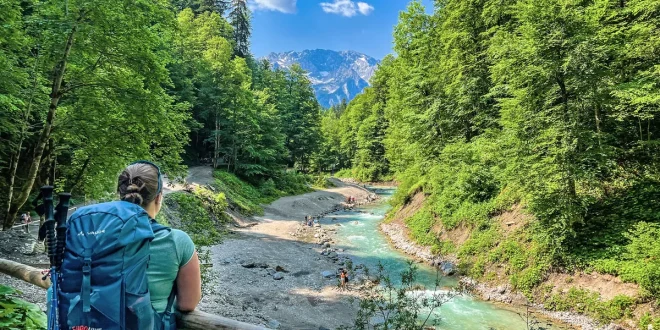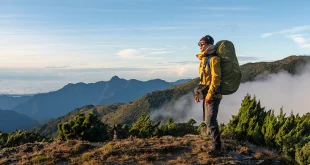Hiking through the great outdoors is an exhilarating experience that lets you connect with nature, but it also comes with its own set of challenges. One of the most important aspects of hiking in wild areas is being prepared for the possibility of encountering wildlife. Although most animals are not aggressive and prefer to avoid humans, certain species can pose a threat if they feel cornered, threatened, or provoked. In this article, I’ll share my own strategies and tips on how to protect yourself from wild animals while hiking, so you can enjoy your adventures with peace of mind.
Stay Alert and Aware of Your Environment
One of the first lessons I’ve learned from hiking in wildlife-rich areas is the importance of staying alert and aware of my surroundings. Wild animals are often more active during certain times of the day, such as early morning or dusk, and it's essential to pay attention to changes in the environment. When I’m hiking, I always keep an eye out for tracks, scat, or signs of animal activity. For example, bear tracks are typically large and deep, while deer tracks are smaller and lighter. Recognizing these signs can alert me to potential wildlife in the area, allowing me to adjust my route if needed.
Another way to stay aware is to use your senses. I listen for sounds such as rustling bushes or snapping twigs, which can signal the presence of an animal. I also pay attention to the wind direction because it can carry the scent of nearby animals. By staying vigilant, I’m not only more likely to spot animals from a safe distance but also avoid unintentionally surprising them, which can often lead to defensive behavior.
Stick to Popular, Well-Established Trails
When I hike, I tend to stick to established trails and paths that are regularly used by other hikers. These trails are typically safer because wild animals are less likely to hang around areas with consistent human traffic. Animals such as bears, mountain lions, and wolves generally prefer solitude and avoid areas where humans frequent. By staying on these well-trodden paths, I minimize the risk of a close encounter with a wild animal, especially when hiking in more remote wilderness areas.
If I do venture off the trail, I make sure I’m well-prepared. This means bringing a map, compass, or GPS device to help me navigate and staying aware of my location. Off-trail hiking often involves thicker vegetation and reduced visibility, which could increase the chances of running into wildlife. In these cases, it’s even more important to move cautiously and stay alert to the signs of animals around me.
Make Your Presence Known
One of the best ways to avoid a dangerous wildlife encounter is by making your presence known to any animals in the area. I have found that making noise as I hike is an easy and effective way to alert animals to my presence. Talking aloud, singing, or clapping my hands regularly lets animals know I’m nearby and allows them to move away before a close encounter happens.
When hiking in bear country, I often use a bear bell, which is a small, jingling bell attached to my backpack or clothing. The sound helps alert bears to my presence without startling them. I’ve found that many animals, including bears, will avoid a confrontation if they can hear a human coming from a distance. In addition, using a whistle or even a small air horn can be useful in areas where animals are particularly active.
Carry Bear Spray and Other Safety Tools
In areas known to be home to large predators like bears, I never leave home without bear spray. Bear spray is a powerful deterrent that can stop a bear in its tracks if it becomes aggressive. I make sure the spray is easily accessible—either attached to the strap of my backpack or carried in a holster on my hip. In an emergency, I can deploy the spray quickly without fumbling for it.
I also recommend bringing a basic first-aid kit, especially when hiking in areas where encounters with wildlife might be more common. The kit should include items like antiseptic wipes, bandages, and any necessary medications in case of an allergic reaction to bites or stings. A small survival kit that contains items such as a whistle, a flashlight, and even a space blanket can be lifesavers if something goes wrong.
Be Mindful of Food and Scented Items
A major factor in attracting wild animals is food. I have learned to always be cautious about how I store food and other scented items like toiletries while hiking. When camping or taking breaks, I ensure my food is sealed in airtight containers and stored in a bear-proof container or hung at least 10 feet off the ground, away from my tent and sleeping area. This minimizes the chance of animals smelling my food and seeking it out.
In addition to food, I avoid bringing any items with strong scents, such as perfumes, lotions, or even heavily-scented sunscreen. Wild animals, especially bears, are drawn to smells, and scented products can make it more likely that they’ll approach my camp or hiking spot. By reducing the presence of scents, I lower the risk of attracting animals in the first place.
Keep a Safe Distance from Animals
While wildlife sightings can be a thrilling part of any hiking trip, it’s essential to maintain a safe distance from any animals you encounter. I always remember that animals are unpredictable and can become aggressive if they feel threatened or cornered. Whether I’m observing a deer grazing or a bear foraging for food, I make sure to give the animal plenty of space. If an animal is in the middle of the trail, I wait until it moves on or find an alternate route to avoid disturbing it.
Taking photos from a distance is fine, but I never attempt to get closer for a better shot. In fact, getting too close can provoke an animal, especially if it’s with its young or feels trapped. I’ve learned to respect their space, as the majority of wildlife encounters that lead to danger are the result of humans getting too close.
Understand Animal Behavior and Reactions
Knowing how to react when encountering wildlife is crucial for staying safe. Each species behaves differently, and understanding these behaviors can help you make the right decisions in a tense situation. For example, if I come across a bear, I avoid running, as this might trigger the bear’s predatory instincts. Instead, I stand my ground, make myself look larger, and slowly back away. It’s important to remember that bears often attack when they feel cornered or threatened, so keeping calm and maintaining a slow retreat can often prevent a conflict.
Similarly, if I encounter a predator like a mountain lion, I know that I must appear as large as possible. I’ve been taught to slowly raise my arms and avoid making any sudden movements. By being calm and measured, I increase my chances of de-escalating the situation.
Conclusion
Hiking in the wild can be a deeply rewarding experience, but it’s crucial to know how to protect yourself from wild animals while hiking. By staying alert, making noise, carrying bear spray, and avoiding attracting animals with food or scents, you can minimize the risk of dangerous encounters. Above all, I’ve learned that respecting wildlife and keeping a safe distance is the key to enjoying the outdoors without putting yourself in harm’s way. Remember, these animals were there long before us, and the best way to stay safe is to understand their behavior, be prepared, and always respect their space.
 Best Hiking Gear Hike More, Worry Less
Best Hiking Gear Hike More, Worry Less

